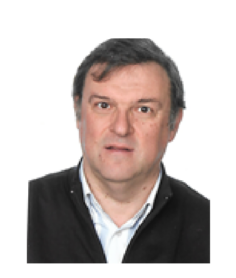Prof. Juan Pablo Martínez Jiménez
 received his doctorate from the Faculty of Sciences at the University of Zaragoza (Spain) in 1994, focusing on hollow cathode electrical discharges in low-pressure gases. He is currently a full professor of Electromagnetism at the same faculty. He coordinates the Electromagnetism Laboratory, with his primary research centered on the electromagnetic characterization of dielectric media and their behavior when mixed in both liquid and solid phases. The evolution of complex dielectric permittivity versus frequency provides critical insights into molecular interactions between polar and non-polar molecules, potential resonance phenomena within the medium, and the frequencies at which maximum energy absorption occurs.
received his doctorate from the Faculty of Sciences at the University of Zaragoza (Spain) in 1994, focusing on hollow cathode electrical discharges in low-pressure gases. He is currently a full professor of Electromagnetism at the same faculty. He coordinates the Electromagnetism Laboratory, with his primary research centered on the electromagnetic characterization of dielectric media and their behavior when mixed in both liquid and solid phases. The evolution of complex dielectric permittivity versus frequency provides critical insights into molecular interactions between polar and non-polar molecules, potential resonance phenomena within the medium, and the frequencies at which maximum energy absorption occurs.
His research also encompasses energy transfer and electromagnetic induction heating phenomena, with applications in both domestic and industrial contexts.
Abstract: Step by step analysis on transitory response for dielectric media (0-10GHz) characterisation using Time domain Reflectometry (TDR)
With the rapid advancements in electronics and telecommunications applications, it is crucial to develop and characterize new materials that provide defined flexible characteristics and enable improved performance. This must be done without losing sight of integration density and device miniaturization.
The transient behaviour of transmission lines (coaxial lines) allows us to analyse the reflected signal of an incident pulse (step) when it encounters an impedance change along the line, a position where we insert the sample to be analysed (Time domain reflectometry, TDR)
The reflected temporal signal contains information from all frequency spectra. Analysing this response through the corresponding Fourier transform enables us to characterize the material’s behaviour in the frequency domain. However, this method presents challenges, such as the rise time of the step and the sampling rate of the reflected signal, which can limit the spectral range of measurements and introduce high-frequency noise that could hinder our characterization.We conduct a detailed step-by-step analysis to explore the behaviour of various dielectric media. Advancements in dielectric material characterization not only have implications in the field of telecommunications but also in a wide range of applications, from power electronics to medicine.
